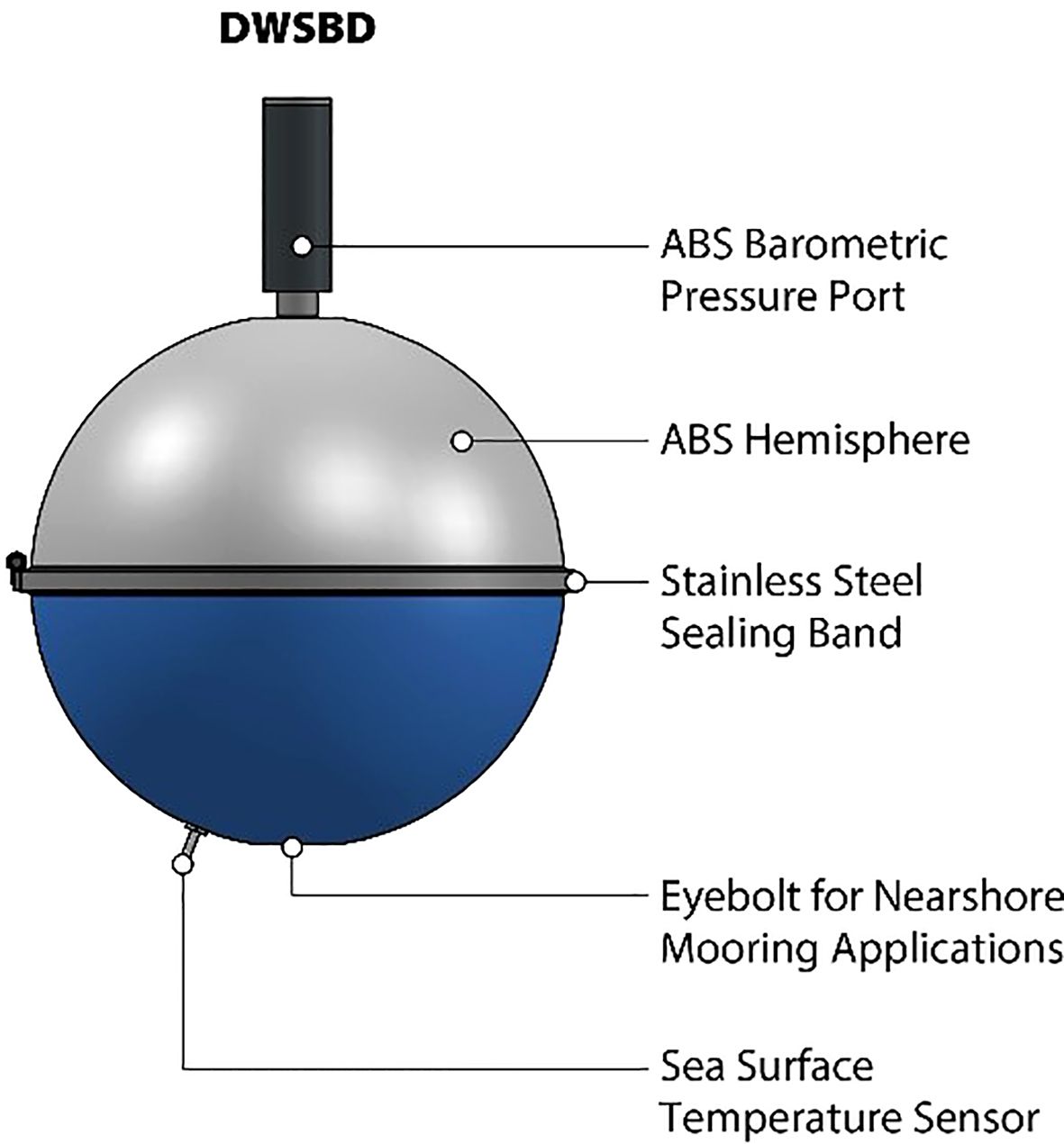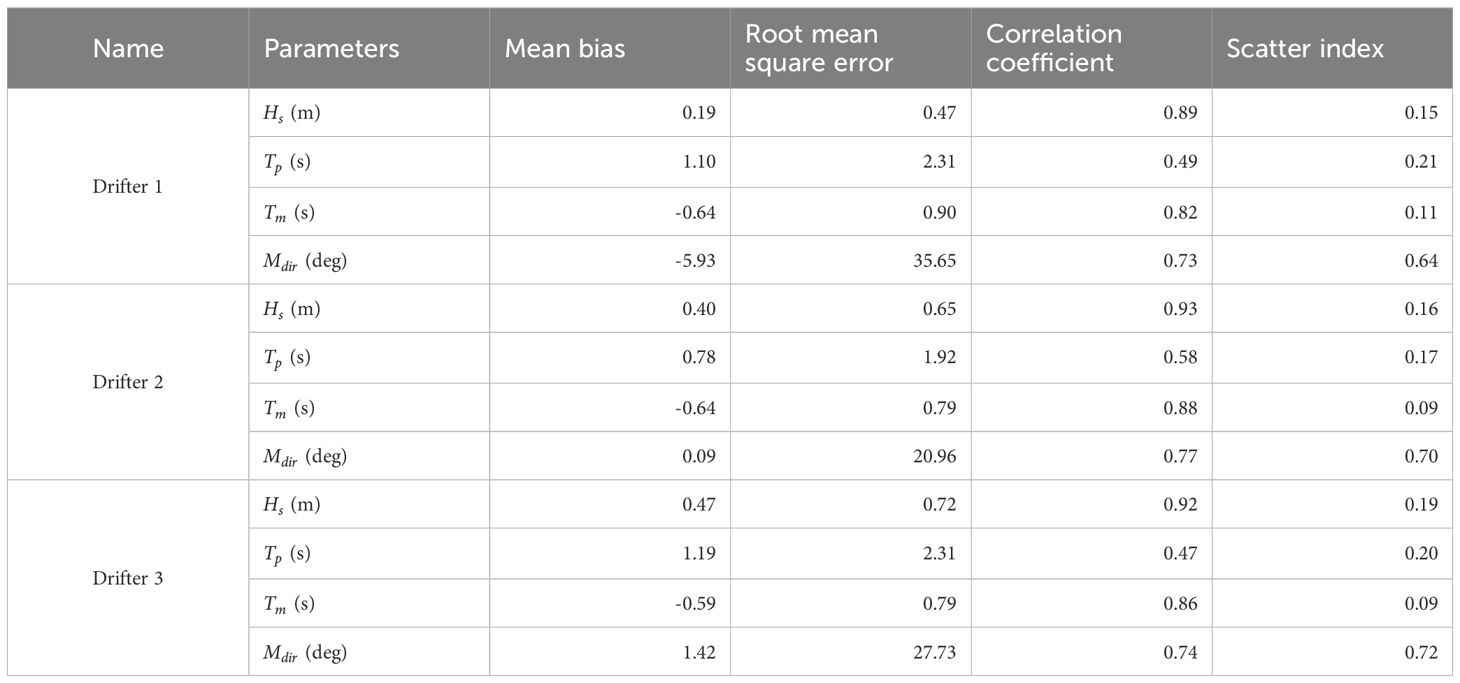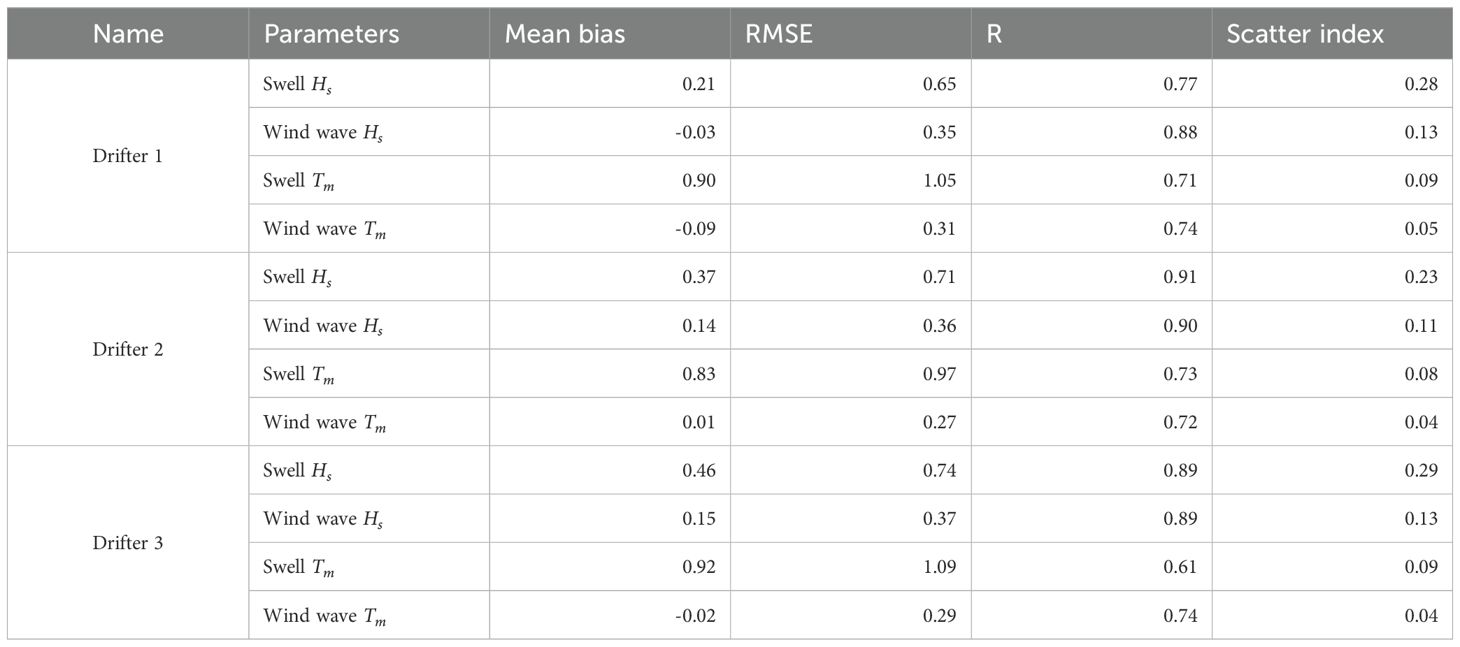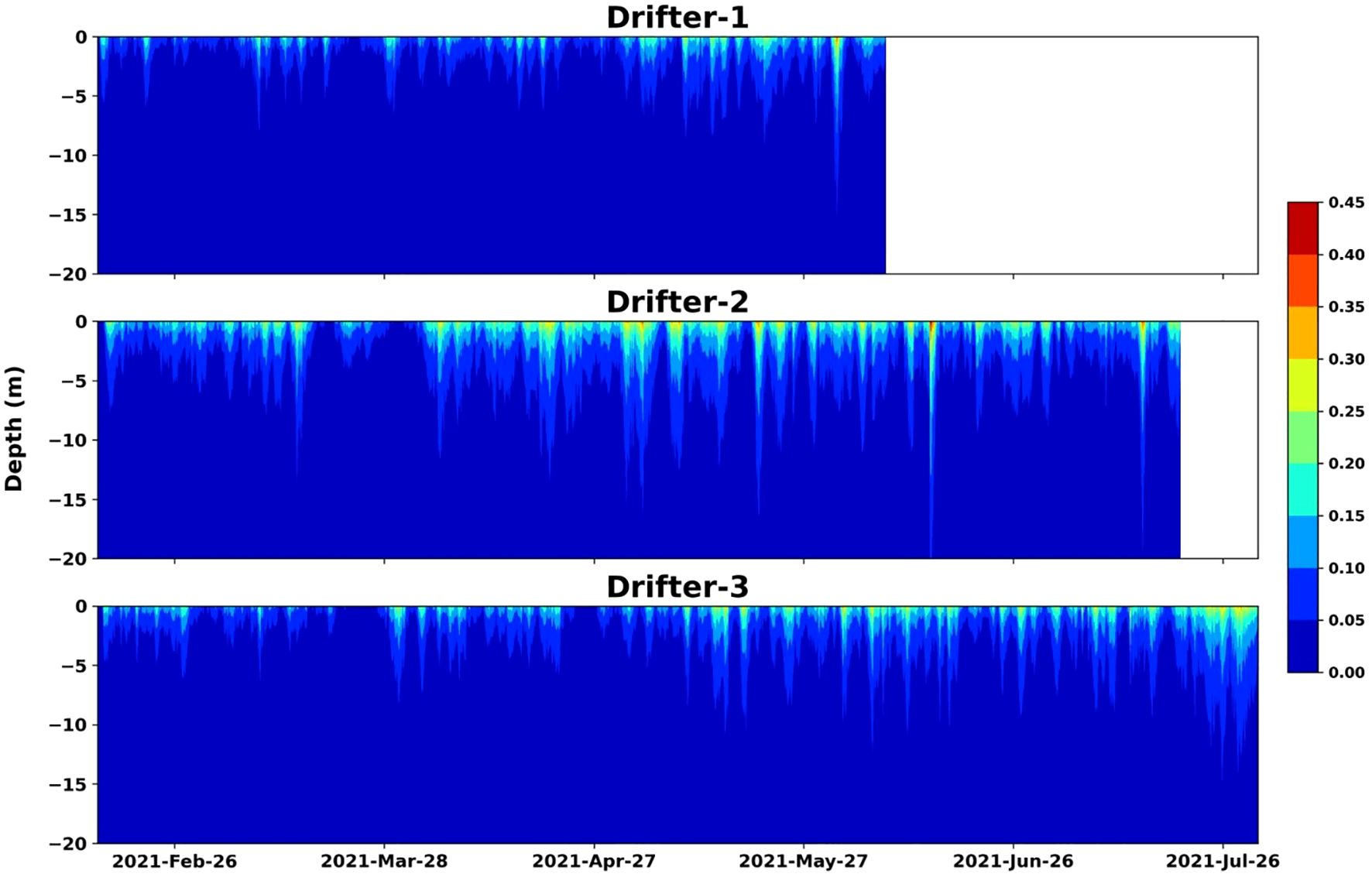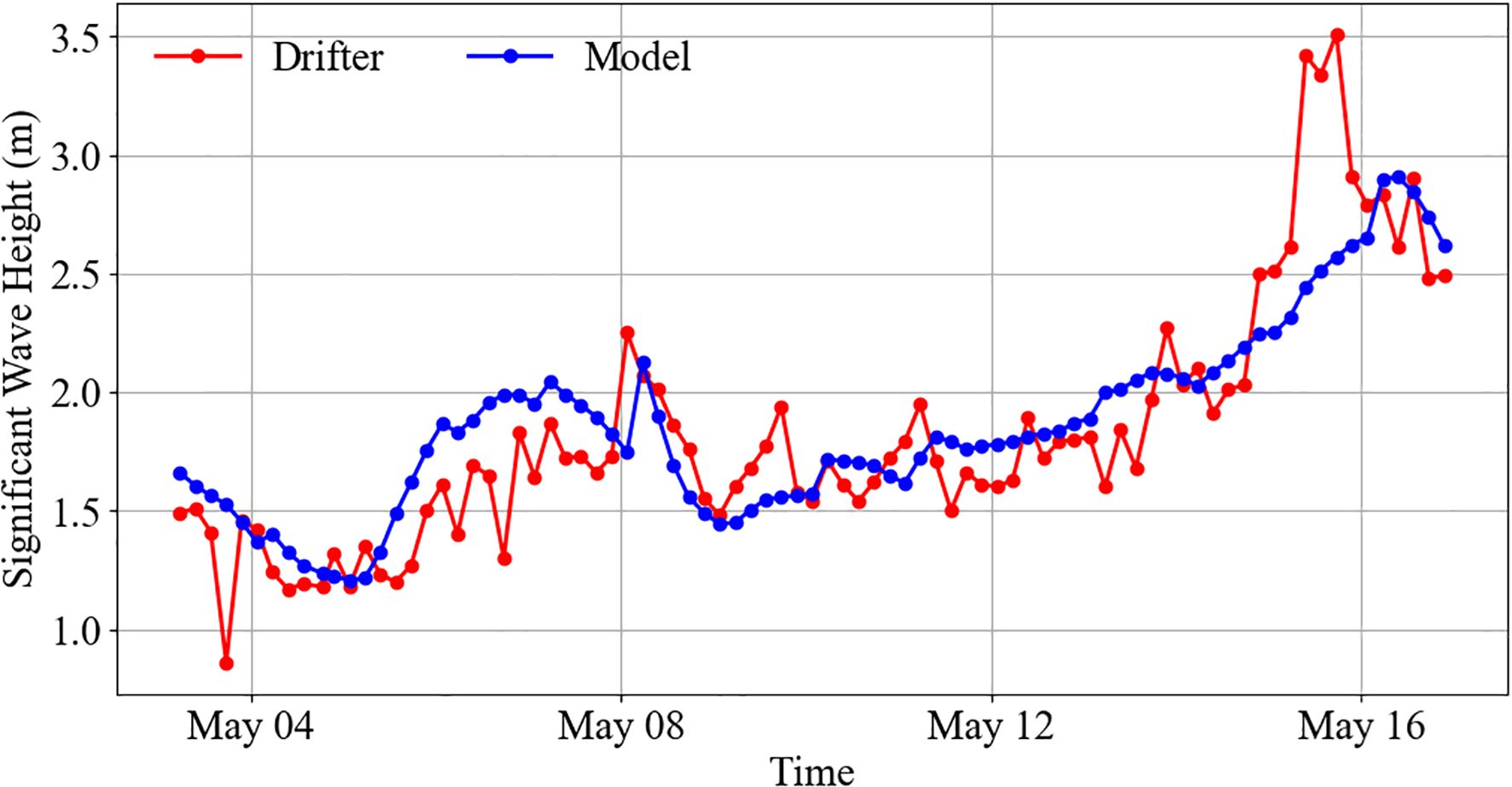- 1Indian National Centre for Ocean Information Services, Ministry of Earth Science (MoES), Hyderabad, India
- 2National Centre for Polar and Ocean Research (NCPOR), Goa, India
The Southern Ocean (SO) is a critical driver of global wave dynamics, generating long-period swells that propagate vast distances and significantly impact far distant coastal regions, including the Indian coastal regions. Climate change has intensified westerly winds and altered storm tracks in the Southern Hemisphere, resulting in higher wave heights and longer periods, which in turn increase the risk to coastal regions. However, the remote and harsh environment in the SO has historically limited in-situ wave observations, hindering a comprehensive understanding of the wave characteristics in the region. To bridge this gap, the Indian National Centre for Ocean Information Services (INCOIS) launched the Indian Ocean Wave Drifter (IOWD) program in 2021 under the Deep Ocean Mission to address the in-situ data gap in the Southern Indian Ocean. Through the deployment of GPS-enabled directional wave spectra drifters, the program has enabled near-real-time observations of wave characteristics across the SO. This article highlights the early outcomes of the IOWD program, including wave model validation, Stokes drift estimation, and swell tracking. The study emphasizes the importance of sustained in-situ observations from remote oceans for improving wave forecasting, enhancing coastal preparedness, and advancing scientific understanding of wave–current interactions and climate variability in the Indian Ocean region.
1 Introduction
The Southern Ocean (SO) plays a pivotal role in global ocean dynamics and climate regulation due to its persistent strong winds, powerful currents, and extreme waves. Bounded by the Antarctic ice sheet to the south and major landmasses to the north, the SO features the planet’s longest uninterrupted fetch, resulting in the generation of the largest and complex wave conditions anywhere on Earth. These waves, often exceeding 10 m in significant height, propagate across the ocean basins as long-period swells and act as global energy transporters (Babanin et al., 2019).
These swell systems have far-reaching impacts, far beyond their point of origin (Remya et al., 2016). The North Indian Ocean (NIO), particularly the southwest coast of India, is notably affected by SO-generated swells. Coastal flooding and freak wave incidents have been consistently linked with these remote swell events (Remya et al., 2012; Nayak et al., 2013; Sabique et al., 2012; Ramakrishnan et al., 2022). A growing body of literature demonstrated this relationship, including the arrival of Atlantic swells on the Indian coast (Samiksha et al., 2012) and the linkage between SO storms and Kallakadal-type flash flooding events along the Indian coast (Remya et al., 2016). Other studies (Majumder et al., 2022; Ramakrishnan et al., 2018) have highlighted the role of SO swells in coastal erosion and the formation of freak waves, which cause severe risks to marine operations and coastal infrastructure.
Climate change has further intensified the influence of SO on global wave patterns. Observations and model studies (Semedo et al., 2012; Hemer et al., 2013) have shown statistically significant increases in significant wave height and wave periods. The intensification and poleward migration of westerly wind belts and storm tracks drive these changes. This results in a global increase in the annual mean wave period, affecting over ~30% of the global Ocean and changes wave propagation directionality (Hemer et al., 2013). Another study by Bhaskaran et al. (2014) based on satellite measurements highlighted that the SO belt, between 40°S – 55°S, experiences the highest variability due to climate change. These trends have profound implications for the Indian Ocean basin, exacerbating nonlinear interactions between wind sea and swell, increasing swell surges and freak waves, and amplifying the risks of extreme wave events.
Despite its global importance, SO remains the most under-observed region of the global Ocean. The extreme sea states, remote location and harsh environmental conditions (colloquially referred to as the ‘Roaring Forties’ and ‘Furious Fifties) pose significant challenges to sustained in situ observations. Satellite altimeters, although valuable, provide only limited data (mainly significant wave height) and lack the directional or spectral information necessary to understand the complexity of swell generation and propagation. Moored buoys are both logistically impractical and financially unsustainable in the harsh SO environments, which highlights the importance of wave drifters as a viable alternative for in-situ observations.
Wave drifters have already proven their utility in different ocean basins. Veras Guimarães et al. (2018) demonstrated that low-cost drifting buoys could capture wave–current interactions in macro-tidal coastal environments. Hisaki (2021) validated drifting-buoy data against moored GPS buoys and ERA5 reanalysis near Japan, demonstrating that drifters provided more accurate wave heights in regions with strong currents. Houghton et al. (2021) further showed that a network of free-drifting Spotter buoys significantly enhanced wave forecast skill, reducing forecast errors and improving swell event detection. Holphe et al. (2025) compared wave displacements from a moored and a drifting Spotter buoy during an accidental voyage in the Indian Ocean, further demonstrating the robustness of drifting buoy measurements. More recently, Wu et al. (2025) used drifting buoys in the Kuroshio Extension to reveal how background currents modulate surface wave characteristics, while Cavaleri et al. (2025) highlighted the potential of small drifting buoys to resolve fine-scale processes such as wave steepness, breaking, and dissipation. Collectively, these studies demonstrate the versatility and reliability of drifting buoys for acquiring high-quality wave data in challenging ocean environments.
Building upon this global evidence, and to address the data scarcity in the Southern Indian Ocean (SIO), the Indian National Centre for Ocean Information Services (INCOIS), under the Ministry of Earth Sciences (MoES, Govt. of India), initiated the Indian Ocean Wave Drifter (IOWD) program in 2021 under its flagship Deep Ocean Mission (DOM). The primary objectives of the IOWD program are to (i) obtain in-situ wave spectra information from the SIO, (ii) reduce observational gaps that limit wave model accuracy in the IO, and (iii) provide datasets to improve both scientific understanding of wave climate variability and operational forecasting. The program employs GPS-based Directional Wave Spectra Drifters (DWSD), developed by the Lagrangian Drifter Laboratory (LDL) at Scripps Institution of Oceanography. The deployment of DWSDs represents a major step forward in addressing the observational gap in SIO and enhancing our understanding of wave dynamics. The IOWD program not only supports scientific advancement and operational forecasting, which are aimed at as the immediate priorities, but also contributes directly to several of the United Nations Sustainable Development Goals (SDGs). It addresses the SDG13 (Climate action) by providing critical data for monitoring and modelling climate induced changes in the ocean; SDG14 (life below water) by supporting ocean health and ecosystem resilience through better wave and current forecasting; and SDG 9 (industry innovation and infrastructure) through the deployment of cutting-edge observational technologies and infrastructure in extreme marine environments.
This article introduces the IOWD program, describes the technical specifications of the DWSDs, outlines the multi-phase implementation strategy, and presents key early applications. These include wave model validation, swell tracking, and Stokes drift estimation, all of which demonstrate the potential of sustained in-situ wave observation in the SO and Indian Ocean region.
2 DWSD technical overview
The Directional Wave Spectra Drifter (DWSD) is a compact, free-drifting, Lagrangian platform designed by the Lagrangian Drifter Laboratory (LDL) at the Scripps Institution of Oceanography (Postacchini et al., 2015; Centurioni, 2017; Centurioni et al., 2017). These compact, cost-effective drifters can transmit real-time, high resolution directional wave spectra and ancillary data from remote and other inaccessible ocean regions.
The DWSD, which weighs 12 kg, consists of a 0.39 m diameter spherical hull that houses a GPS receiver, batteries, data acquisition electronics, and an Iridium satellite modem (Figure 1). It is powered by replaceable alkaline or lithium batteries, offering extended mission durations, depending on the sampling duration and environmental conditions. The GPS sensor in the DWSD records 3D velocity time series (zonal and meridional), at a sampling rate of 2 Hz for 17 minutes every hour. The power spectral density, co-spectra and quadrature-spectra parameters are derived with the Fourier transforms of the correlation functions of each pair of the velocity time-series, giving the first five independent Fourier coefficients (a0, a1, a2, b1, b2) and thus the wave spectra for each hourly sea state. The drifter transmits data in real-time via the Iridium satellite system, including Significant wave height (Hs), Mean wave period (Tm), Mean wave direction (Mdir), Peak wave period (Tp), Peak wave direction (Pdir) and wave spectra. Metadata, such as timestamp, location, battery voltage, sea level pressure, and sea surface temperature, is also included in the data stream. Using two-way communication via Iridium, the sampling strategy can be reconfigured, allowing adaptive observation strategies in response to evolving ocean conditions.
To ensure the accuracy and reliability of the drifter data, a comprehensive quality control procedure was implemented. Data from the initial test phase was excluded to remove potential anomalies and inconsistencies. Outliers were identified and eliminated based on a threshold of five times the standard deviation to preserve data integrity. Additionally, any data points with zero and stuck values were discarded. The geographic positions of the drifters were verified to ensure they fell within the designated oceanic domain. This multi-step quality control process ensured that only high-quality, consistent data were retained for subsequent analysis (Figure 2).
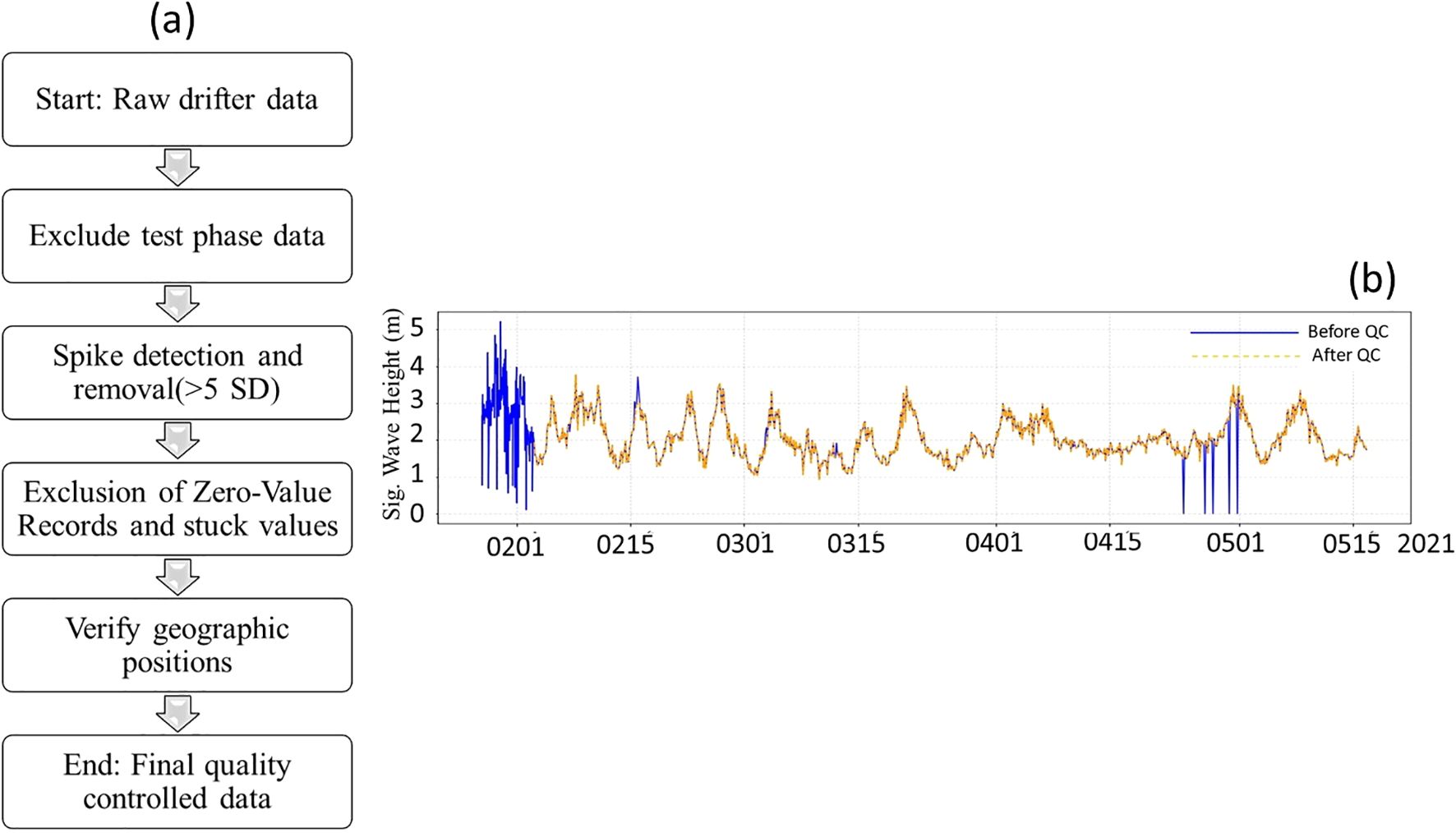
Figure 2. (A) Flowchart of the quality control procedure applied to drifter data (B) Comparison of raw drifter data and quality-controlled data.
3 Indian Ocean Wave Drifter program
The IOWD program was initiated in 2021 under DOM by MoES, Govt. of India, aimed at exploring and harnessing the vast potential of the depths of the Ocean through a mission-mode approach. It focuses on six key themes: development of technologies for deep-sea mining and underwater robotics, ocean climate change advisory services, sustainable use of marine bio-resources, deep ocean survey and exploration, extraction of energy and freshwater from the Ocean, and establishing an advanced marine station for ocean biology. INCOIS is leading the development of climate change advisory services, and the drifter program is a part of this vertical. The program was started under the DOM in 2021. IOWD is envisaged as a continuous program, with 30 drifter deployments planned every year. The implementation so far has been carried out in multiple phases, leveraging the cruise opportunities to optimize the spatial coverage and data return. The continuing IOWD program can fill the critical gap in obtaining observed wave spectra from the SO, providing essential insights into the changing wave dynamics and climate perspective of this remote and challenging region.
The initial phase involved the deployment of 4 DWSD during the Southern Ocean Expedition by the National Centre for Polar and Ocean Research (NCPOR) in 2021, onboard MV Vasily Golovnin, targeting the high swell regions of the Southern Indian Ocean (SIO). These deployments provided valuable insights into early mission planning, system endurance and real-time telemetry. Subsequent deployments occurred in 2023 and 2024, expanding the geographic scope and increasing the number of drifters. A fleet of 30 drifters was deployed from RV Roger Revelle (20 numbers) and ORV Sagar Nidhi (10 numbers), covering the SIO and tropical Indian Ocean basins, respectively. These deployments were carefully planned to enable long period swell tracking from the SIO into the tropical oceans.
In addition to targeting swell propagating tracks, the program also focuses on deployments in areas influenced by mesoscale eddies and strong boundary currents to examine the wave-current interactions. During the 2024–2025 Antarctic expedition, 3 drifters were deployed in the marginal ice zones to study the wave-ice interactions.
Figure 3 shows along-track Hs values of the drifters from first, second and third phase deployments. It is evident from the figures that the drifters are effectively covering the remote areas and transmitting the data for a long period. The longest continuous dataset lasted 292 days, with most drifters functioning for more than six months—highlighting their significance in remote wave observations. Real-time data reception and remote configurability allowed the research team to optimize sampling schedules and adapt to evolving weather and wave conditions. The cumulative data return has established a high resolution, multi-season observational archive that supports not only basic research and validation, but also operational oceanography.
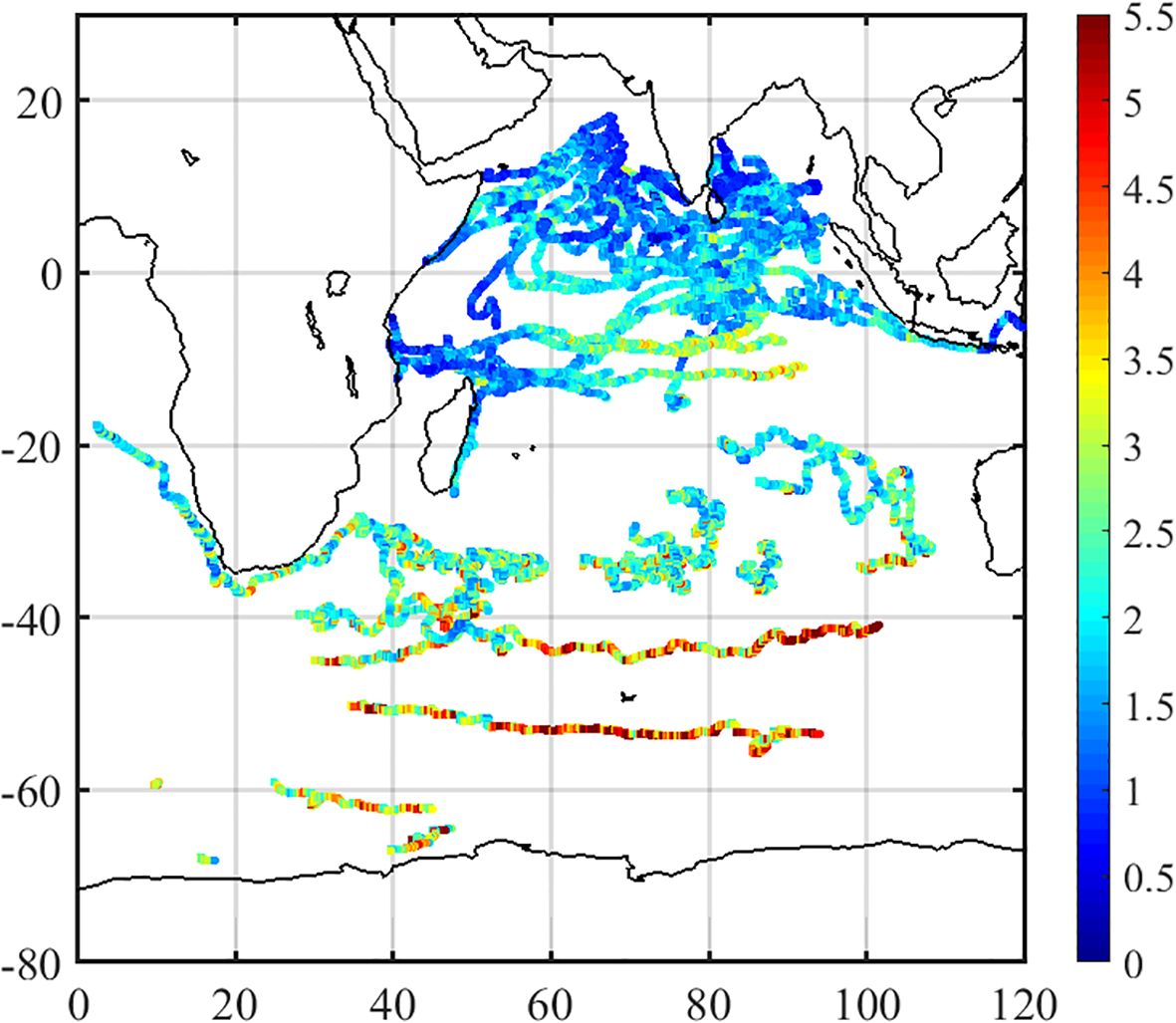
Figure 3. Wave drifter tracks of first, second and third phase deployment in the Indian Ocean; color represents significant wave height (m) along the tracks.
4 A few key applications of the IOWD program
In the following section, we highlight a few key applications of the IOWD program, using the DWSD data from the first phase deployment. These examples demonstrate the value of the program and its impact on advancing wave research. Although all drifters were initially deployed in the SIO, one drifter (drifter 4) drifted into the Atlantic Ocean, while the remaining three continued to operate within the SIO. The drifter tracks are shown in Figure 4A. Figure 4B presents the along-track time evolution of energy density recorded by the drifters. Notably, drifter 3 has provided a long data series spanning around 6 months until July 2021.
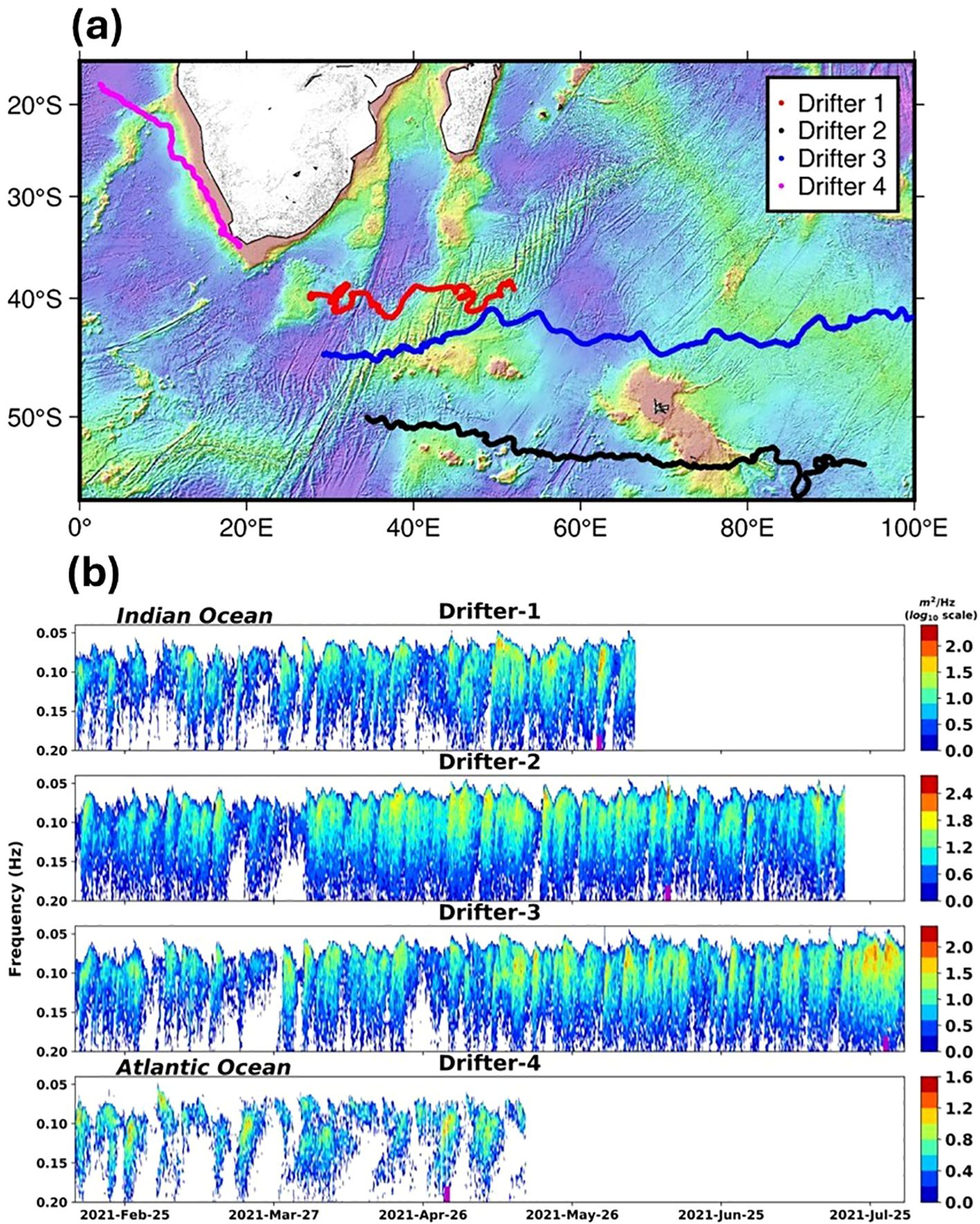
Figure 4. (A) Wave drifter tracks of initial deployment in the SO (B) Wave energy density along the drifter tracks.
4.1 Wave model validation
INCOIS runs a suite of wave models for various applications, including wave forecasting, climate service development, and wave research in the IO. The WAVEWATCH III model has been used for both global and regional wave forecasting applications. Until the initiation of the IOWD program, model studies relied on satellite altimeter-derived significant wave height () for the validation of SO waves. Since the initiation of the drifter program, model results have now been validated using drifter wave parameters. Figure 5 shows the time series comparison of modeled wave parameters with drifter observations for a representative drifter, demonstrating good agreement across all parameters. Tm exhibits a slight negative bias, whereas Hs shows good agreement, even at the highest wave heights (>10 m), proving the reliability of the model predictions in the southernmost latitudes. The observed mean wave direction () was mostly within the range of 225° – 315°, and the model-predicted values followed the same pattern. Table 1 presents the model error statistics for the comparison, illustrating the good agreement between the model and drifter observations in the southern latitudes. From Table 1, it can be seen that the scatter index values are less than 0.25 for , , and for all drifters, while shows higher errors compared to the other parameters.
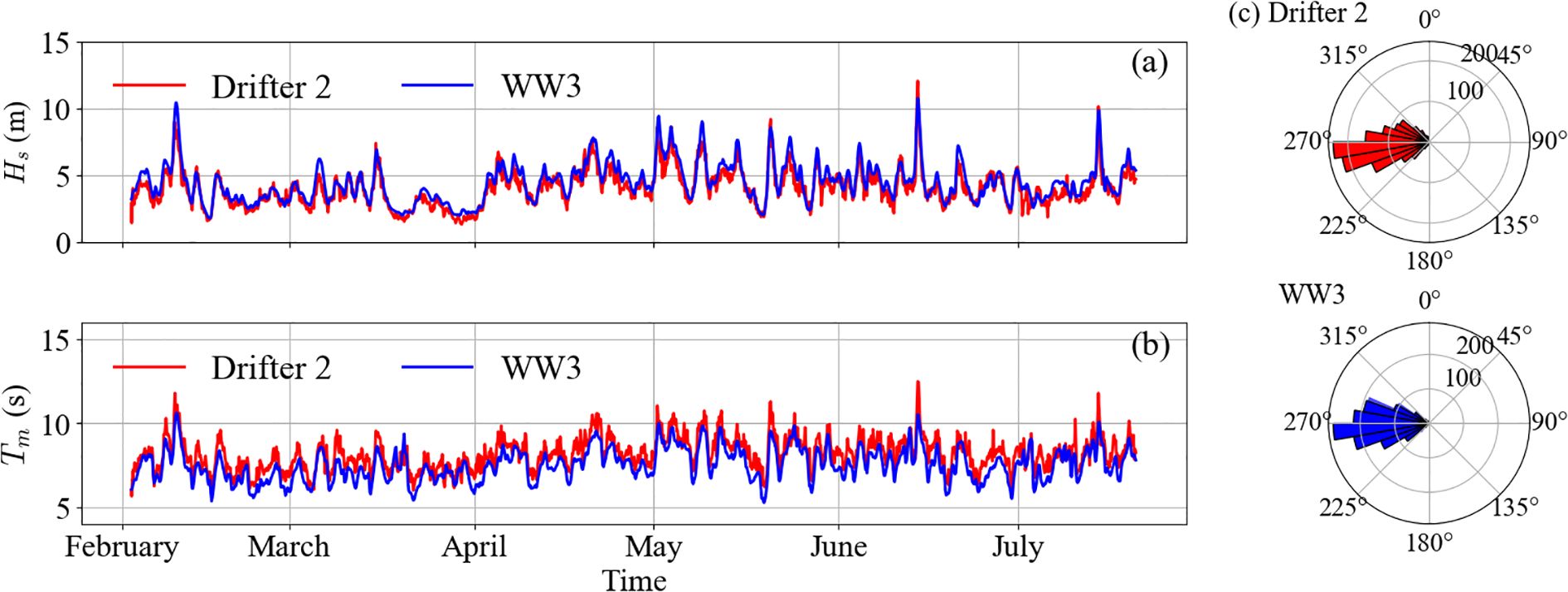
Figure 5. (A, B) Time series comparison of , of model and drifter observations along the track of Drifter 2 (C) wave rose plot for .
At times, the drifter was located within storm-affected regions, where it measured high-energy spectra that were subsequently used for model validation. Figure 6 shows two such examples involving Drifter 2 and Drifter 3. In the first case, Drifter 2 was in a region of strong storm-induced winds and recorded a peak energy density of approximately 320 m²/Hz. Although the model captured the overall spectral shape, it was unable to reproduce the peak of spectral energy density observed at 03 UTC on 14 June. However, the model did simulate peak spectral energy density of ~160 m²/Hz at 12 UTC on the same day.
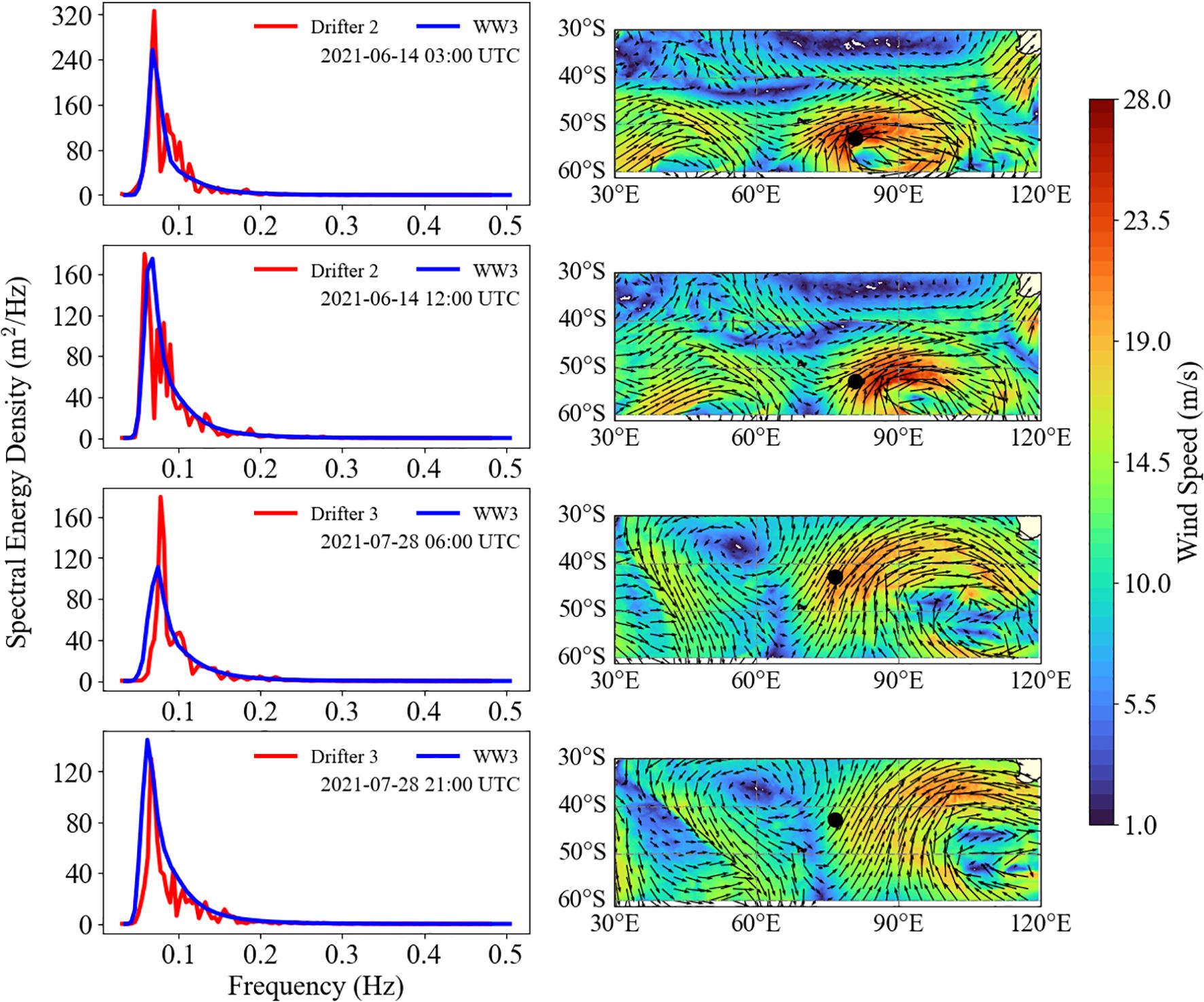
Figure 6. (Left panel) One dimensional wave spectra comparison of model and wave drifter during two storm cases on 14th June (drifter 2) and 28th July (drifter 3), 2021; (Right panel) wind speed and direction in the storm area and the black spot shows drifter positions.
In the second case, Drifter 3 was in a storm region on 28 July 2021. Like the first case, the model failed to reproduce the observed peak spectral energy density (~170 m²/Hz) at 06 UTC, although it closely matched the observed spectra at 21 UTC on the same day. The errors in simulating storm-induced wave fields are largely attributed to inaccuracies in forecast wind inputs, as well as inadequacies in the parameterization schemes used in the model (Raj et al., 2023).
A potential solution to address these uncertainties is the assimilation of observational data. As seen in Figure 6, the drifters effectively captured the highest energy levels during storm conditions, and assimilating such data can substantially improve wave forecasts. Increasing the number of drifter deployments in the SIO will enhance opportunities to capture such events and contribute to more accurate forecasting of wave fields and swell propagation in the region.
4.2 Tracking of the SO swells
One of the main objectives of the drifter program was the utilization of data for tracking and the study of the SO swells. The SO swells are controlling the NIO wave characteristics and have a significant impact on the Indian coastal areas. The changing patterns of swells due to climate change can have a significant impact on Indian coastal regions in terms of flooding and coastal erosion. Since there are no swell fields available from satellite altimeters/synthetic aperture radar directly, SO swell validation is unattainable. We have used a constant threshold frequency criterion (0.1 Hz) and made the sea and swell separation both from model and drifter. The validation of separated wave fields is shown in Figure 7. As seen in Figure 3, Drifter 2 tracks fall within a high wave height and swell-dominated regime and are therefore chosen as a representative track for the validation. The swell wave fields show close agreement with the drifter data, even during periods of high swell wave heights, whereas the swell wave period is overestimated, indicating an energy shift towards the lower-frequency part of the spectrum in the wave model (Figure 7). Wind sea heights and periods were in good agreement with the observations. Table 2 provides the error statistics of the model for the three drifters. The scatter index of the heights and periods of wind sea and swell is well below 0.3, indicating better performance of the forecast model in the SIO. Ocean current data were not included in the present wave model simulations, and this omission may have introduced biases, particularly in the South Indian Ocean, where strong currents are common. Future work will address wave–current interactions in the Indian Ocean using drifter observations.
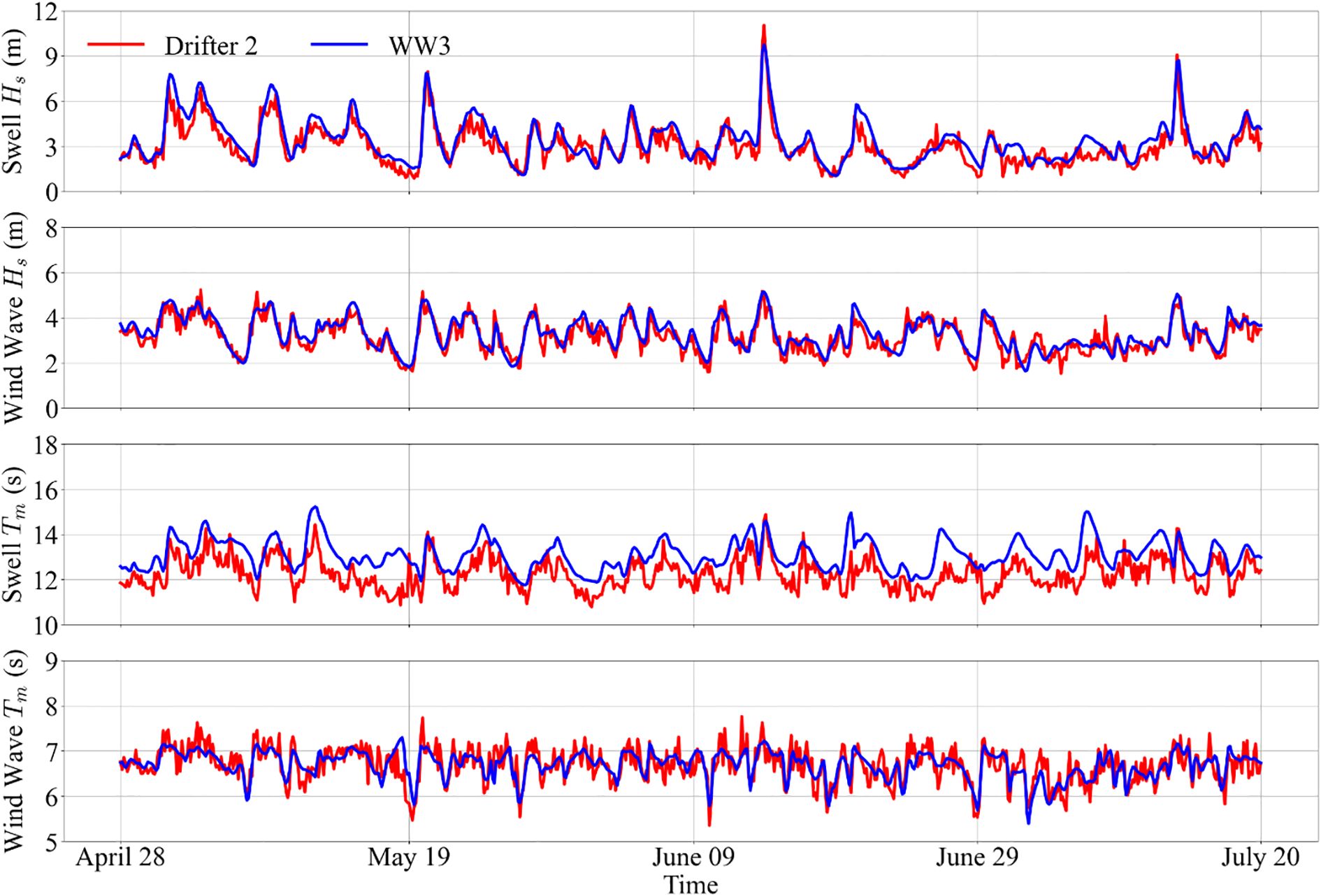
Figure 7. Time series comparison of , of swell and wind sea of model and drifter observations along the track of drifter 2.
4.3 DWSD derived stokes drift and model comparison
During its periodic motion, a particle floating at the free surface of a water wave experiences a net drift velocity in the direction of wave propagation, known as the Stokes drift (Stokes, 1847). Ocean surface waves mainly contribute to turbulent kinetic energy and turbulent mixing throughout the mixed layer through Stokes drift and wave breaking. The Stokes drift is considered as an important parameter in the ocean-wave coupled model for representing the Langmuir effect. Additionally, Stokes drift is considered as an important parameter in the particle tracking model. It also plays a significant role in wave-induced turbulent mixing within climate system models (Fan et al., 2023). In the first few meters below the surface, Stokes drift influences the motion of drifters with shallow drogue and drifter observations allow the calculation of Stokes drift and the methodology is as follows.
If the one-dimensional variance spectra is used, the Stokes drift can be computed as (Kenyon, 1969):
where g is gravity and z is the water depth, negative downward, f is the frequency, Evar, one dimensional wave spectrum.
Using Equation 1, Stokes drift has been computed from the drifter data for three drifters and is shown in Figure 8. The analysis shows maximum Stokes drift values near the surface, decreasing with depth, consistent with theoretical expectations. The WW3 model also provides surface Stokes drift. Therefore, the computed surface Stokes drift from the drifters is used to validate the WW3 model-derived Stokes drift (Figure 9). The model shows good agreement with the drifter data, with a slight negative bias along all three drifter tracks, demonstrating the reliability of the model-derived surface Stokes drift. This validation builds confidence in using the model data for coupling applications and as input for particle tracking models.
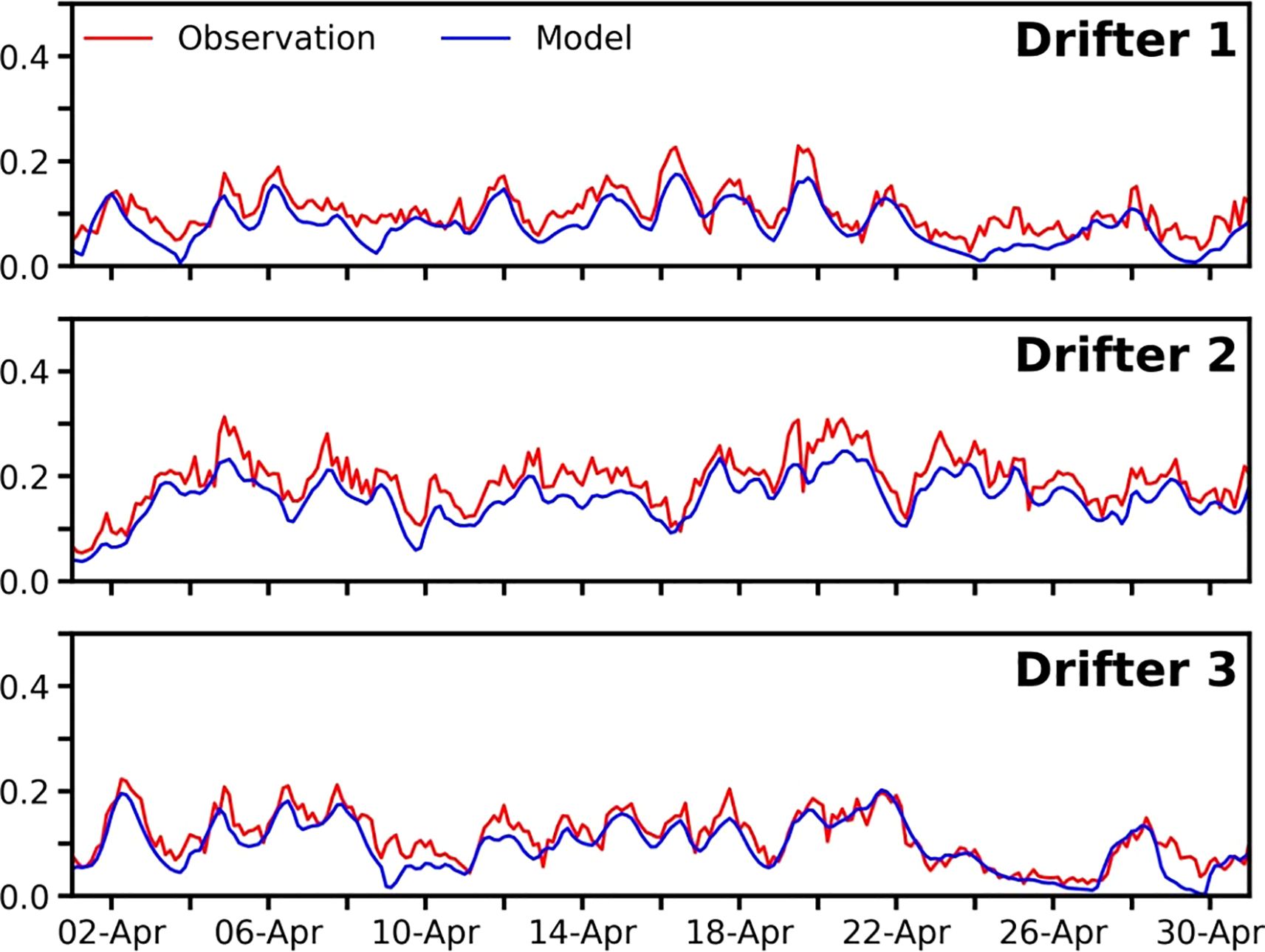
Figure 9. Comparison of model derived stokes drift (m/s) with wave drifter derived stokes drift (m/s).
5 Real-time applications and future research directions
The Indian Ocean Wave Drifter (IOWD) program has already demonstrated substantial potential for integration into real-time operational forecasting systems and long-term climate monitoring. One of the immediate applications of the DWSD has been the real-time validation of daily forecasts. Figure 10 illustrates one example of real-time validation of the INCOIS wave forecast using drifter data from a remote location, as displayed on the website www.incois.gov.in. The availability of near-real-time wave data has enabled operational forecast centers to assess model performance under varying sea conditions. This validation enables the credibility of wave forecast products disseminated to end users. Another near-future operational application is the assimilation of DWSD data in operational models.
The IOWD dataset also supports the development of improved warning systems for swell-induced coastal hazards. By capturing the spectral and directional characteristics of incoming swell waves, the drifters provide key inputs for inferring regional-scale wave forecasts. This contributes to early warnings for Kallakkadal-type events and other forms of coastal flooding. The real-time transmission of data from remote ocean regions fills a critical observation gap that previously limited the accuracy of such warnings.
Looking ahead, the IOWD data archive is expected to serve as a reference dataset for evaluating long-term trends in wave energy and spectral characteristics. This is particularly relevant for understanding the influence of climate change on the SO wave climate and its teleconnections to the Indian Ocean. Future deployments will include targeted campaigns in polar and tropical zones, enabling studies of wave-ice interactions, mixed wave-current regimes, and air-sea exchange processes. Furthermore, there is significant scope for coupling DWSD observations with other oceanographic datasets, such as those from Argo floats, gliders, satellite altimetry, eddy covariance sensors etc. This multi-platform synergy will enable comprehensive assessments of wave-current interactions, upper ocean mixing, and momentum transfer. The drifters also hold promises to improve Stokes drift estimates, which are essential for applications ranging from marine pollution tracking to search-and-rescue operations.
6 Summary and way forward
The Indian Ocean Wave Drifter (IOWD) program is an important initiative for addressing a long-standing gap in in-situ observations across the Indian ocean, particularly in areas where in-situ mooring deployments are not feasible. The Southern Ocean (SO), a region critical to global wave generation and climate regulation, remains especially under sampled due to its remoteness and harsh conditions. The IOWD program, launched in 2021, under the Deep Ocean Mission (DOM) of MoES, aims to overcome these challenges by deploying GPS-based Directional Wave Spectra Drifters (DWSD), capable of transmitting wave spectra, sea level pressure and sea surface temperature from remote areas, in near-real time.
The program has already enabled several high-impact applications including validation of wave forecast models, data assimilation, tracking of long-period swells, estimation of Stokes drift, etc. The availability of wave spectra observations from remote and data-scarce regions will significantly advance our understanding of swell propagation in the IO, its role in coastal flooding, and the dynamics of wave–current interaction.
Despite its successes, the IOWD program also faces several operational challenges. A notable percentage of deployed drifters have been affected with vandalism, beaching, and premature death limiting their effective life span and data continuity. Even though 37% of the 64 DWSD worked more than 250 days. Retrieval and redeployment operations are resource intensive and logistically demanding. Additionally, consistent access to ideal deployment tracks in the SO regions remains a major constraint, often hindering the deployment of drifters in key swell-generating zones. These challenges underscore the need for robust deployment planning and international collaboration, including coordinated ship time and shared observation strategies.
The broader implications of the IOWD program are substantial. By improving wave forecast accuracy in one of the most dynamic wave-generating regions, the program directly contributes to marine safety, the protection of coastal infrastructure, and enhanced disaster preparedness. Accurate wave predictions support early warnings for swell surges and extreme wave events, reducing risks to maritime operations and vulnerable coastal communities. The real-time and long-term drifter observations also provide crucial inputs for global climate models, helping refine projections of sea level rise and wave climate under changing atmospheric conditions. In this way, the IOWD program supports more informed and actionable climate adaptation policies.
From a strategic perspective, the IOWD program reflects commitment of India to the United Nations Decade of Ocean Science and aligns with Sustainable Development Goals (SDG 9, 13 and 14). Through sustained operation and expansion, the program is expected to generate significant new research, particularly in wave dynamics of the Indian Ocean, and foster technological and scientific innovation in ocean observing systems. The program will continue under the framework of DOM, with plans to procure additional wave drifters yearly for deployment across various parts of the Indian Ocean—particularly in key under-sampled regions. With continued support and collaboration, the IOWD program is poised to become a flagship contribution from India to the global ocean observing community, advancing wave forecasting, climate research and coastal resilience for years to come.
Data availability statement
The datasets presented in this study can be found in online repositories. The names of the repository/repositories and accession number(s) can be found below: Available through request https://www.incois.gov.in/site/datainfo/OON.jsp.
Author contributions
PGR: Visualization, Resources, Validation, Data curation, Project administration, Conceptualization, Formal Analysis, Writing – review & editing, Methodology, Investigation, Writing – original draft, Software, Supervision. NK: Methodology, Writing – review & editing, Data curation, Resources, Project administration. SM: Formal Analysis, Visualization, Writing – review & editing, Validation. BK: Formal Analysis, Writing – review & editing, Writing – original draft. TA: Formal Analysis, Visualization, Data curation, Writing – review & editing. VR: Data curation, Writing – review & editing. CJ: Data curation, Writing – review & editing. AL: Funding acquisition, Project administration, Writing – review & editing, Supervision. ER: Funding acquisition, Writing – review & editing, Project administration, Supervision. TM: Project administration, Writing – review & editing, Supervision, Funding acquisition.
Funding
The author(s) declare financial support was received for the research and/or publication of this article. The research and the IOWD program is funded by Ministry of Earth Science, Govt. of India.
Acknowledgments
We thank Dr. M Ravichandran, Secretary, MoES for his support. We acknowledge the support of Dr. Yogesh Ray, Scientist, NCPOR, Voyage leader and team for initial deployment. We thank Langragian drifter laboratory, Dr. Luca Centurioni and Dr. Lance Braasch for DWSD development and support. Thanks to Chief Scientist of R/V Roger Revelle (RR 2308), Voyage Leader of M/V Vasiliy Golovnin (44th ISEA), Chief Scientist of R/V Sindhu Sankalp for second and third phase deployments. This research and IOWD program falls under OCCAS-Deep Ocean Mission and is funded by Ministry of Earth Science, Govt. of India. We thank the developers of WAVEWATCH III NOAA/NCEP for providing the WAVEWATCH III source code (https://polar.ncep.noaa.gov/waves/) and for their consistent efforts to improve the accuracy of this open-source spectral model. We used MIHIR HPC facility for the wave model experiments. We thank two reviewers for their critical comments and suggestions. This is INCOIS contribution number 591.
Conflict of interest
The authors declare that the research was conducted in the absence of any commercial or financial relationships that could be construed as a potential conflict of interest.
Generative AI statement
The author(s) declare that no Generative AI was used in the creation of this manuscript.
Any alternative text (alt text) provided alongside figures in this article has been generated by Frontiers with the support of artificial intelligence and reasonable efforts have been made to ensure accuracy, including review by the authors wherever possible. If you identify any issues, please contact us.
Publisher’s note
All claims expressed in this article are solely those of the authors and do not necessarily represent those of their affiliated organizations, or those of the publisher, the editors and the reviewers. Any product that may be evaluated in this article, or claim that may be made by its manufacturer, is not guaranteed or endorsed by the publisher.
References
Babanin A. V., Rogers W. E., De Camargo R., Doble M., Durrant T., Filchuk K., et al. (2019). Waves and swells in high wind and extreme fetches, measurements in the Southern Ocean. Front. Mar. Sci. 6. doi: 10.3389/fmars.2019.00361
Bhaskaran P. K., Gupta N., and Dash M. K. (2014). Wind-wave climate projections for the Indian Ocean from satellite observations. J. Mar. Sci. Res. Dev. S 11, 005. doi: 10.4172/2155-9910.S11-005
Cavaleri L., Alari V., Benetazzo A., Björkqvist J.-V., Breivik Ø., Davis J., et al. (2025). More room at the top: how small buoys help reveal the detailed dynamics of the air–sea interface. Bull. Amer. Meteor. Soc 106, E1063–E1076. doi: 10.1175/BAMS-D-24-0120.1
Centurioni L. R. (2017). “Drifter technology and impacts for sea surface temperature, sea-level pressure, and ocean circulation studies,” in Observing the oceans in real time (Springer International Publishing, Cham), 37–57. doi: 10.1007/978-3-319-66493-4_3
Centurioni L., Braasch L., Di Lauro E., Contestabile P., De Leo F., Casotti R., et al. (2017). A new strategic wave measurement station off naples port main breakwater. Coast. Eng. Proc. 1, 36. doi: 10.9753/icce.v35.waves.36
Fan P., Jin J., Guo R., Li G., and Zhou G. (2023). The effects of wave-induced Stokes drift and mixing induced by nonbreaking surface waves on the ocean in a climate system ocean model. J. Mar. Sci. Eng. 11, 1868. doi: 10.3390/jmse11101868
Hemer M. A., Fan Y., Mori N., Semedo A., and Wang X. L. (2013). Projected changes in wave climate from a multi-model ensemble. Nat. Climate Change 3, 471–476. doi: 10.1038/nclimate1791
Hisaki Y. (2021). Validation of drifting buoy data for ocean wave observation. J. Mar. Sci. Engineering. 9, 729. doi: 10.3390/jmse9070729
Hlophe T., Taylor P. H., Hansen J. E., Wolgamot H., and Cuttler M. V. W. (2025). Comparison of vector wave displacements from a moored and a drifting Spotter buoy—from an accidental Indian Ocean voyage. Ocean Eng. 328. doi: 10.1016/j.oceaneng.2025.120967
Houghton I. A., Smit P. B., Clark D., Dunning C., Fisher A., Nidzieko N. J., et al. (2021). Performance statistics of a real-time pacific ocean weather sensor network. J. Atmos. Oceanic Technol. 38. doi: 10.1175/JTECH-D-20-0187.1
Kenyon K. E. (1969). Stokes drift for random gravity waves. J. Geophysical Res. 74, 6991–6994. doi: 10.1029/JC074i028p06991
Majumder S., Remya P. G., and Nair T. B. (2022). Analysis of meteorological and oceanic conditions during freak wave events in the Indian Ocean. Ocean Eng. 259, 111920. doi: 10.1016/j.oceaneng.2022.111920
Nayak S., Bhaskaran P. K., Venkatesan R., and Dasgupta S. (2013). Modulation of local wind-waves at Kalpakkam from remote forcing effects of Southern Ocean swells. Ocean Eng. 64, 23–35. doi: 10.1016/j.oceaneng.2013.02.010
Postacchini M., Centurioni L. R., Braasch L., Brocchini M., and Vicinanza D. (2015). Lagrangian observations of waves and currents from the river drifter. IEEE J. Oceanic Eng. 41, 94–104. doi: 10.1109/JOE.2015.2418171
Raj A., Kumar B. P., Remya P. G., Sreejith M., and Nair T. B. (2023). Assessment of the forecasting potential of WAVEWATCH III model under different Indian Ocean wave conditions. J. Earth System Sci. 132, p.32. doi: 10.1007/s12040-023-02045-w
Ramakrishnan R., Agrawal R., Remya P. G., NagaKumar K., Demudu G., Rajawat A. S., et al. (2018). Modelling coastal erosion: A case study of Yarada beach near Visakhapatnam, east coast of India. Ocean Coast. Manage. 156. doi: 10.1016/j.ocecoaman.2017.08.013
Ramakrishnan R, Remya PG, Mandal A, Mohanty P, Arayakandy P, Mahendra RS, et al. (2022). Wave induced coastal flooding along the southwest coast of India during tropical cyclone Tauktae. Sci. Rep. 12, 19966. doi: 10.1038/s41598-022-24557-z
Remya P. G., Kumar R R., Basu S., and Sarkar A. (2012). Wave hindcast experiments in the Indian Ocean using MIKE 21 SW model. J. Earth Syst. Sci. 121, 385–392. doi: 10.1007/s12040-012-0169-7
Remya P. G., Vishnu S., Praveen Kumar B., Balakrishnan Nair T. M., and Rohith B. (2016). Teleconnection between the North Indian Ocean high swell events and meteorological conditions over the Southern Indian Ocean. J. Geophysical Research: Oceans 121, 7476–7494. doi: 10.1002/2016JC011723
Sabique L., Annapurnaiah K., Nair T. B., and Srinivas K. (2012). Contribution of Southern Indian Ocean swells on the wave heights in the Northern Indian Ocean—A modeling study. Ocean Eng. 43, 113–120. doi: 10.1016/j.oceaneng.2011.12.024
Samiksha S. V., Vethamony P., Aboobacker V. M., and Rashmi R. (2012). Propagation of Atlantic Ocean swells in the north Indian Ocean: a case study. Natural Hazards Earth System Sci. 12, 3605–3615. doi: 10.5194/nhess-12-3605-2012
Semedo A., Weisse R., Behrens A., Sterl A., Bengtsson L., and Günther H. (2012). Projection of global wave climate change toward the end of the twenty-first century. J. Climate 26, 8269–8288. doi: 10.1175/JCLI-D-12-00658.1
Veras Guimarães P., Ardhuin F., Sutherland P., Accensi M., Hamon M., Pérignon Y., et al. (2018). A surface kinematics buoy (SKIB) for wave–current interaction studies. Ocean Sci. 14, 1449–1460. doi: 10.5194/os-14-1449-2018
Keywords: directional wave spectra drifter, southern ocean, ocean surface waves, deep ocean mission, indian ocean wave drifter program
Citation: Remya PG, Suresh Kumar N, Mithun SB, Praveen Kumar B, Anoop TR, Reddem VS, Jeyakumar C, Lotliker AA, Rao EPR and Nair TMB (2025) Preliminary analysis and applications of the Indian Ocean wave drifter program. Front. Mar. Sci. 12:1642772. doi: 10.3389/fmars.2025.1642772
Received: 07 June 2025; Accepted: 03 October 2025;
Published: 30 October 2025.
Edited by:
Jian Wang, Tianjin University, ChinaReviewed by:
Samiran Mandal, Indian Institute of Technology Delhi, IndiaYukiharu Hisaki, University of the Ryukyus, Japan
Copyright © 2025 Remya, Suresh Kumar, Mithun, Praveen Kumar, Anoop, Reddem, Jeyakumar, Lotliker, Rao and Nair. This is an open-access article distributed under the terms of the Creative Commons Attribution License (CC BY). The use, distribution or reproduction in other forums is permitted, provided the original author(s) and the copyright owner(s) are credited and that the original publication in this journal is cited, in accordance with accepted academic practice. No use, distribution or reproduction is permitted which does not comply with these terms.
*Correspondence: P. G. Remya, cmVteWEucGdAaW5jb2lzLmdvdi5pbg==
 P. G. Remya
P. G. Remya N. Suresh Kumar1
N. Suresh Kumar1 B. Praveen Kumar
B. Praveen Kumar Venkat Shesu Reddem
Venkat Shesu Reddem Aneesh A. Lotliker
Aneesh A. Lotliker T. M. Balakrishnan Nair
T. M. Balakrishnan Nair